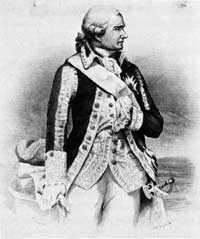|
YORKTOWN National Battlefield |
 |
Siege of Yorktown
(continued)
ASSEMBLY OF THE ALLIED ARMIES. On September 7, Lafayette moved his force from the Pamunkey River to Williamsburg where he could at least temporarily block any movement that Cornwallis might make up the peninsula. His army was substantially enlarged the next day by the more than 3,000 troops under St. Simon, who had arrived with De Grasse and landed at Jamestown. On September 14, Washington arrived at Lafayette's headquarters in Williamsburg for a "joyful reunion" with the young French general and to assume direct command of the operations in the Virginia theater.
The combined French and American forces, which Washington had left at the head of the Chesapeake early in September, found a shortage of shipping also at Head-of-Elk. It was necessary to use most of the vessels available for the transport of ordnance and stores, with the result that the bulk of the troops had to march on to Baltimore and Annapolis to embark. On September 15, Washington wrote to De Grasse about the transport of his army. The French admiral had anticipated this need, and had already dispatched the transports brought to the area from Newport by De Barras plus some frigates which had been seized—enough to accommodate about 4,000 troops.
 Count de Rochambean, Commander of the French wing of the allied armies which besieged Yorktown. |
On September 17, Washington, with Rochambeau, Chastellux, Henry Knox, and the Chevalier Duportail, visited De Grasse aboard the Ville de Paris to pay their respects and to confer on the joint operation now in progress against Cornwallis. In the discussion, Washington was able to prevail on De Grasse to extend his stay in Virginia waters past the October 15 deadline which he had originally set. He agreed to remain at least through the month of October. He did not, however, approve plans to move ships into the York River.
By September 22, when Washington returned to Williamsburg, parts of the allied armies from the North had arrived, having landed along College Creek and at other points on the James. Included among the troops, too, was a force under M. de Choisy which had come down from Newport with De Barras. Late in the same day other parts of the convoy, which De Grasse had sent up the bay, began to arrive, and De Grasse was able to write: "Everything is entering the river today, even your artillery." Landing operations continued for several days with much of the artillery being put ashore at Trebell's Landing below College Creek.
About this time the allied commanders learned that the English fleet in New York had been augmented by the arrival of a squadron under Adm. Robert Digby. This led to apprehension on the part of De Grasse and increased the need for haste in operations against Yorktown. De Grasse debated the need of putting to sea—a turn of events that caused Washington moments of "painful anxiety." In the end, however, De Grasse was persuaded against this move, and he remained in the bay. Nevertheless, the need for immediate land action had become imperative.
By September 27, the organization of the allied French and American armies assembled at Williamsburg had been completed. There were three parts—American Continentals (approximately 5,200), French auxiliaries (about 7,500), and American militia (over 3,000). The Continentals were grouped in three divisions, commanded respectively by Major General Lafayette, Major General von Steuben, and Major General Lincoln. In addition to his divisional duties, Lincoln also commanded the American wing. Detachments of artillery, with siege and field pieces, several companies of sappers and miners, and other units, were under the command of Brig. Gen. Henry Knox of Massachusetts. There was a cavalry grouping too, under Col. Stephen Moylan of Pennsylvania.
The French wing of the allied armies made up approximately one-half of the total land forces which opposed the British. Commanded by the Count de Rochambeau, it included 7 infantry regiments grouped in 3 brigades. The cavalry was under the Duke de Lauzun and the artillery under Colonel d'Aboville. The French engineers were headed by Colonel Desandrouins and Lieutenant Colonel Querenet, both of whom were instrumental in the preparation of an excellent set of siege plans.
The third component of the allied armies was the militia, chiefly from Virginia, commanded by Gen. Thomas Nelson, Jr., a native of Yorktown, who was supported by Brig. Gen. George Weedon, Brig. Gen. Robert Lawson, and Brig. Gen. Edward Stevens.

|

| History | Links to the Past | National Park Service | Search | Contact |
|
Last Modified: Mon, Dec 2 2002 10:00:00 am PDT |

